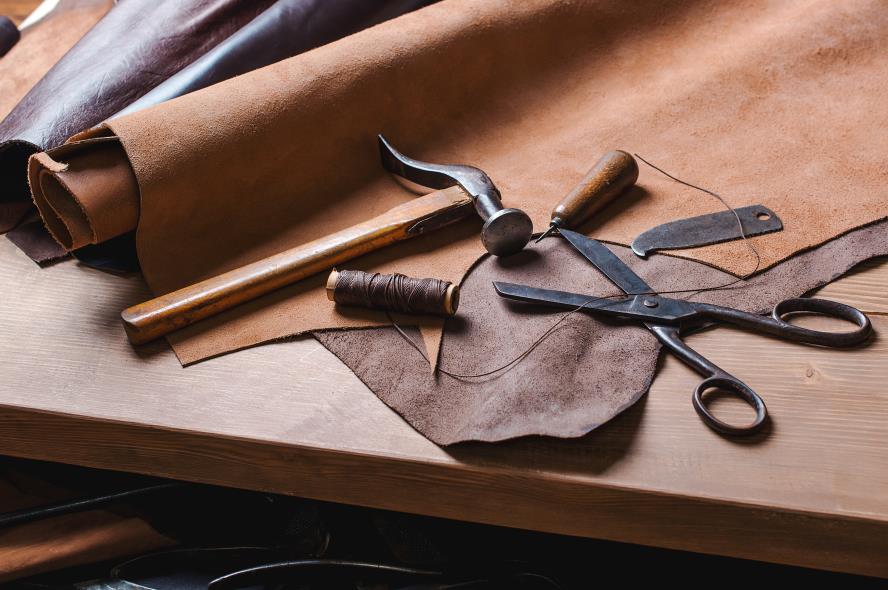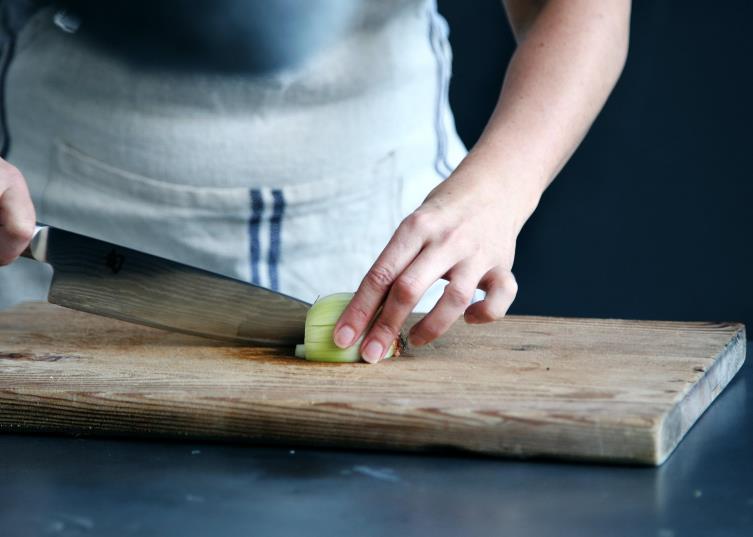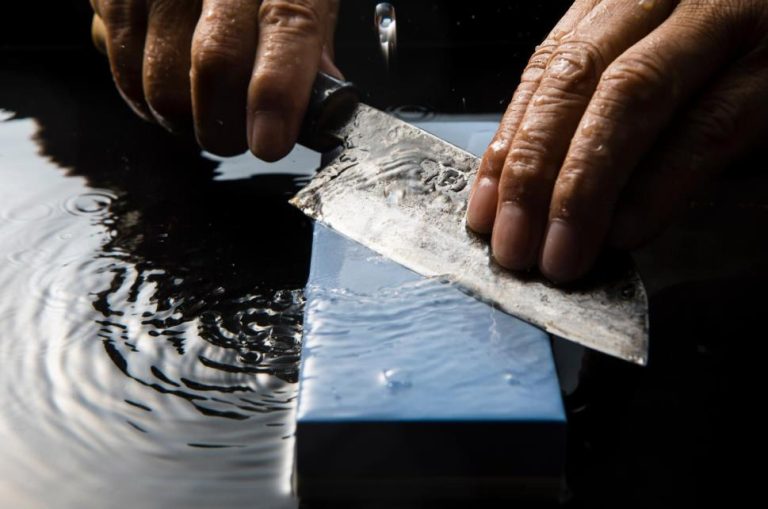Sheaths offer protection to the blades and their owners. It’s the safest method for preventing accidents and damage to the knife. Knife sheaths are a must for any store selling products for outdoor enthusiasts and kitchen knives for grills and barbecues.
There are various sheath materials, but the most convenient one is leather. It’s a flexible yet durable material and doesn’t dull the cutting edge like rigid materials.
However, there are many types of leather. With the many options available, managers and owners can have challenges making the right decision. This article is here to help troubled knife store owners and managers find the most suitable leather for their businesses.
We will cover the types of leather for knife sheaths and review each variety’s features, pros, and cons.
Why sell leather knife sheaths?
Leather makes a good knife sheath for several reasons. It’s gentle on knives, durable, and doesn’t expect much care from your customers. Here are the top reasons why leather makes the best sheath material.
For knives
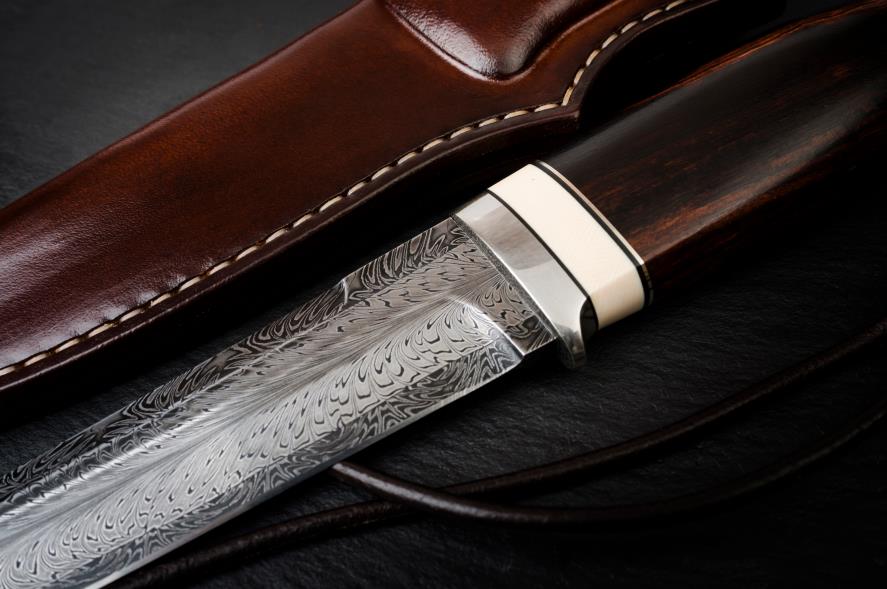
The knife goes in and out of the sheath constantly. Contact is unavoidable whenever your customers put the knife in the sheath and take it out. With leather sheaths, the blade’s tip or the cutting edge doesn’t get damaged. This ensures that knives remain protected.
An appropriately fitting leather sheath will withstand even a razor-sharp knife. The leather’s resistance to scrapes also means the sheath maintains its original looks. It takes a considerable time before scratches or knife marks appear on the inside or outside the leather sheath.
While leather is sturdy enough to bear impacts and friction from knives, it takes it lightly. Leather doesn’t dull knives, prolonging the sharpness of blades. It’s gentle on knives, much like end-grain cutting boards. This good relationship leather sheaths have with knives is enough to convince knife enthusiasts.
For users
Leather is stylish and comfortable to wear. Even if it touches the skin, it won’t cause irritations. It’s flexible and not rigid like some synthetic materials. When carrying a leather sheath with a belt clip, moving around with it won’t cause any disturbance to the user.
Leather knife sheaths are also among the most durable. Under any weather condition, whether wet or dry, leather preserves its smooth surface. It won’t crack or lose its color with enough attention. Leather sheaths don’t ask much from the user for decades of use. Occasionally cleaning and drying it when needed and polishing it with a conditioner is enough.
Additionally, leather sheaths fit every user’s budget. They can get a standard one priced at no more than $20 or choose a top-quality leather for up to $100. With a wide price range, leather makes an accessible sheath material for buyers with different budgets.
Buy Wholesale Leather Sheath and Start Scaling up with Us Today
Contact us and connect with a sales rep to get a free quote.
Leather types used for making knife sheaths
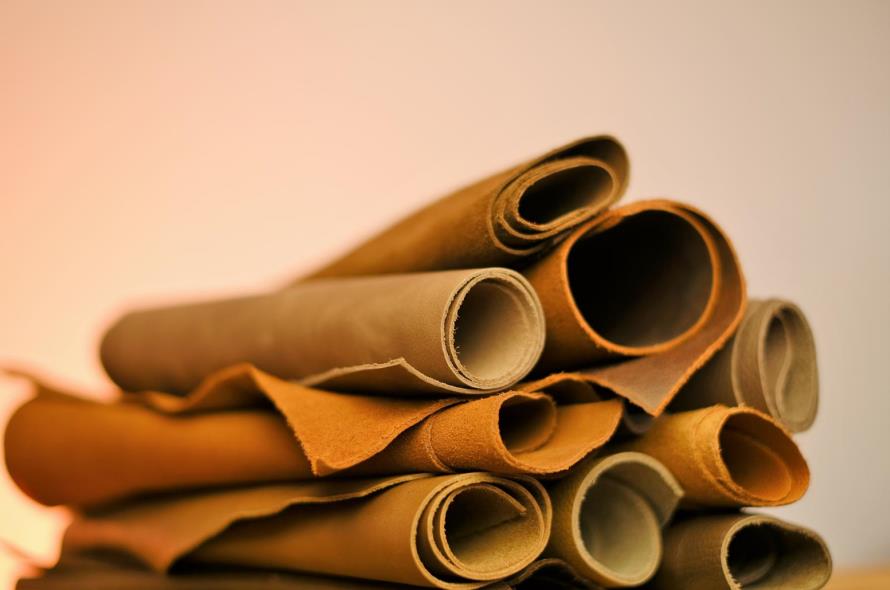
Hopefully, these were enough to give you a basic understanding of why we favor leather knife sheaths.
There isn’t a single leather type, so these are what you’ll find when looking to outsource leather knife sheaths to sell.
- Real leather
- Full grain leather
- Top grain leather
- Split leather
- Crazy horse leather
- Artificial leather
- PU leather
- PVC leather
Here is a breakdown of each type’s features, advantages, and disadvantages.
Real leather
Natural leather’s authenticity is the first reason users turn to them for various products. Real leather offers the best durability, from clothing to knife sheaths. The quality you can present to your customers varies, depending on your choice.
Full grain leather
The tanner, the person making leather, acquires full grain leather by removing the hair and immediately moving it to the tanning process. This leather type contains the natural surface of the leather, making it resist moisture superbly.
Over time, full grain leather usually develops a patina similar to carbon steel knives. However, the patina is more prominent in vegetable-tanned leather – more on tanning methods below.
As the leather ages, it becomes stronger. While full grain leather offers durability and water resistance, it’s thick and tough to work for manufacturers. It’s easier to shape them into pocket-sized knives.
For this reason, there aren’t many knife sheaths made from full grain leather. They are better for large-sized blades, such as lengthy chef’s knives, machetes, and swords.
Pros
- It has the natural properties of the animal’s hide and skin. Full grain leather is incredibly durable and the highest grade.
- The patina developed over time adds to the strength of full grain leather.
Cons
- It’s often challenging to work with for making knife sheaths.
- Full grain leather is more expensive than others that can give just as good qualities to sheaths.
Top grain leather
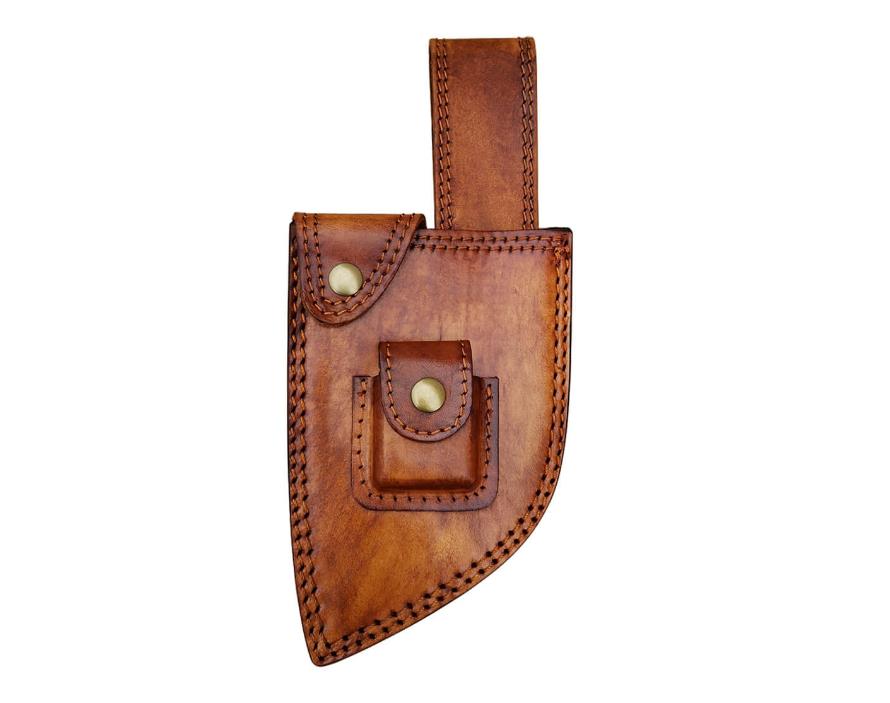
Top grain leather is slim yet incredibly durable against wear and tear. Tanners get this by splitting the full grain leather, shaving off the excess, which is then made into split leather – more on that in a bit. That said, top grain leather consists of the outermost layer of full grain leather, hence the name.
This real leather type is perhaps the most popular leather for knife sheaths. It’s suitable for knife blades of all sizes. It’s easier to shape them, even for curved knives, thanks to their slimness. Top grain leather knife sheaths resist water and moisture incredibly well and aren’t prone to cracking.
Aside from its functionality, the top grain leather makes a striking knife sheath. The tanners can apply a variety of finishes to the surface. This also gives them an even polish. The smooth texture is why luxury brands always use top grain leather for their products – it just feels good to touch.
Pros
- Scratches and marks caused by the knife won’t be visible quickly. It takes years of wear and tear for them to appear.
- The smooth texture gives it a distinct look and feel.
- The easy workability makes them fit all kinds of knives and user likings. You can sell top grain knife sheaths with various looks, finishes, and colors.
Cons
- Top grain leather is more flimsy, requiring a more consistent upkeep routine. Conditioning the leather frequently is a must for these knife sheaths, especially after being wet.
- Although it has a pleasant touch, top grain leather doesn’t breathe much. It can get uncomfortable to wear on humid and hot days.
Split leather

After removing the excess for top grain leather, tanners don’t just throw the extra down in the trash. It’s processed and used for making split leather. This leather type is the most affordable but may not satisfy everyone. It lacks some of the durability features the others have.
Split leather doesn’t have tightly packed fibers, unlike the others. It’s the second or third cut of the hide with a rough texture. Since it isn’t as dense, split leather isn’t so resistant to scratches. Considering how repeatedly a knife goes in and out of the sheath, it can tear up quickly.
All these aren’t to say that split leather is not fit for making knife sheaths. It’s a good option for storage, not for actual out-in-the-field use. If you’re selling collector’s items, split leather is a viable option you can trust.
Pros
- Split leather has adequate water and moisture resistance.
- The level of breathability makes split leather comfortable to wear occasionally.
- It’s significantly more affordable than other real leather types.
Cons
- The durability isn’t enough to endure daily use.
- Knife marks become apparent and can shed the leather.
- It doesn’t have a leather-ish look like the others, appearing much like a densely packed piece of clothing.
Crazy horse leather

Crazy horse leather is somewhat different than others mentioned in this article.
Crazy horse leather is an umbrella term for leather made following a specific technique. Manufacturers can make crazy horse leather using full grain, top grain, or split leather. Tanners utilize different tanning methods, but chrome tanning is the most widespread.
Tanners start by polishing the leather, which softens it. The leather is then treated with a special type of wax that creates friction, deepening its color. This process gives the leather a lively texture and a remarkable finish.
The wax provides the surface water-repelling features that protect the fibers, ensuring it lasts for decades with adequate care. Crazy horse leather also develops a patina and grows stronger.
This process can be handmade or by a machine. The handmade crazy horse leather is more expensive, as expected. Like the other natural leather types, there are ranging qualities with crazy horse leather.
Full grain crazy horse leather is the most expensive, while the bonded alternatives are the least. Bonded leather refers to leather containing both natural and artificial materials.
Pros
- The unique texture makes it satisfying to touch.
- The deep colors unique to crazy horse leather make it luxurious.
- It’s incredibly water-resistant, repelling water like a non-porous material.
- The patina develops quickly – even the natural oils in our fingers speed up the process. The fast patina boosts crazy horse leather’s strength quickly.
Cons
- During the making, scratch-like marks appear as a by-product of applying the wax. This can be unfavorable to buyers looking for a brand-new look.
- The multiple-step to produce crazy horse leather makes it pricy.
Buy Wholesale Leather Sheath and Start Scaling up with Us Today
Contact us and connect with a sales rep to get a free quote.
Artificial leather
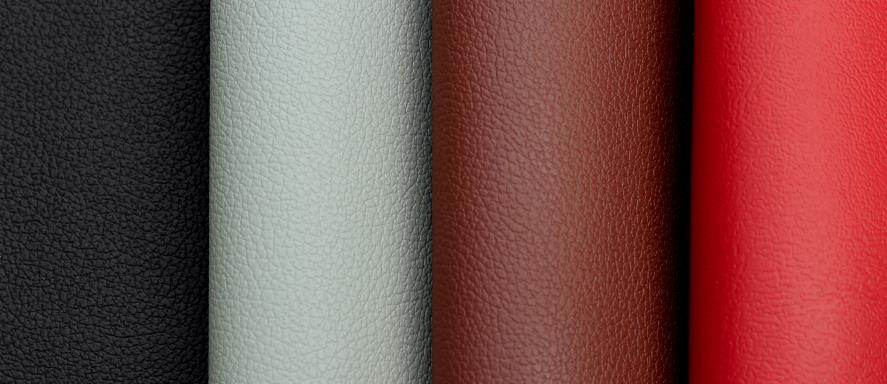
The artificial (faux) leather imitates real leather’s looks. Manufacturers can make them with various materials, with each having certain qualities of its own. They are the only vegan alternative to knife enthusiasts favoring the leather’s appearance.
The same as real leather, artificially created leathers have varieties.
PU leather
Polyurethane leather, shortly referred to as PU leather, uses thermoplastic polymer. Some variations also contain real leather with a polyurethane coat, known as bicast leather.
PU leather has a bumpy texture with a smooth finish. The most common uses of this artificial leather are with furniture, apparel, and cars.
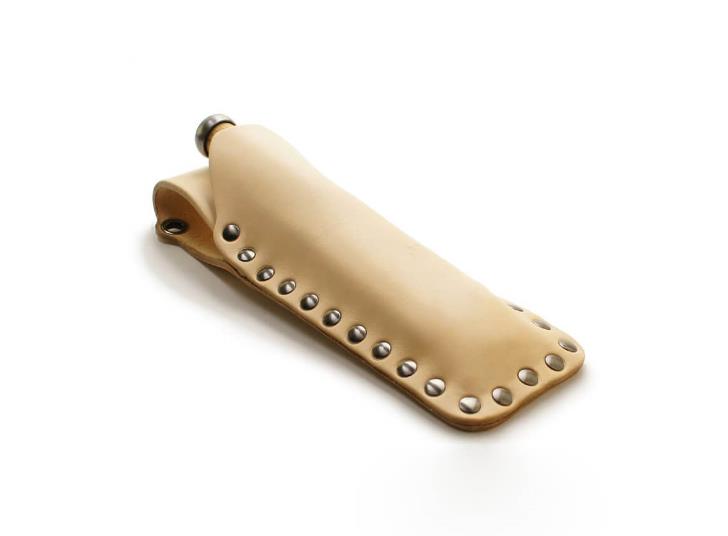
The benefit of PU leather over the real thing is maintenance requirements, which are none. It’s also relatively more sustainable, requiring fewer resources to create. They come in a broad range of colors, don’t absorb water, and are inexpensive compared to real leather.
Pros
- It’s affordable – you can sell them half the price of real leather, if not less.
- PU leather doesn’t dry and require upkeep.
- It doesn’t absorb moisture, making it comfortable to wear in tactical situations and easy to clean.
Cons
- It doesn’t have much breathability. This can make the user sweat or cause irritations after long stretches of wearing.
- Being artificial, it doesn’t biodegrade and isn’t environment-friendly.
- Durability isn’t enough to sustain prolonged use. It can tear up, puncture, or warp easily and doesn’t develop a patina like real leather.
PVC leather
PVC leather uses polyvinyl chloride. Producing PVC leather requires harsh chemicals that pose a threat to the environment. It’s ecologically destructive and is nowhere near the sustainability of PU leather.
Due to this reason alone, many manufacturers stopped producing PVC leather and opted for the polyurethane alternative.
This synthetic leather is still prominent in apparel, especially footwear. PVC leather has a foam layer with a plastic coat on the outside. It imitates natural leather well with a better structure than PU leather.
The foam layer, skin layer, and final plastic-based coat make PVC more durable than PU. However, it’s harder to work with and less breathable. Since moisture on the blade won’t evaporate easily in PVC leather, it can oxidize the knife when in the sheath.
Pros
- The most durable synthetic leather. It can stand extreme weather conditions and sudden temperature changes.
- PVC leather doesn’t have many pores, making sheaths easy to clean and sanitize.
Cons
- The manufacturing process uses many chemicals that affect the environment badly.
- It doesn’t have much breathability, which can lead to irritations when sported for prolonged periods.
Leather tanning
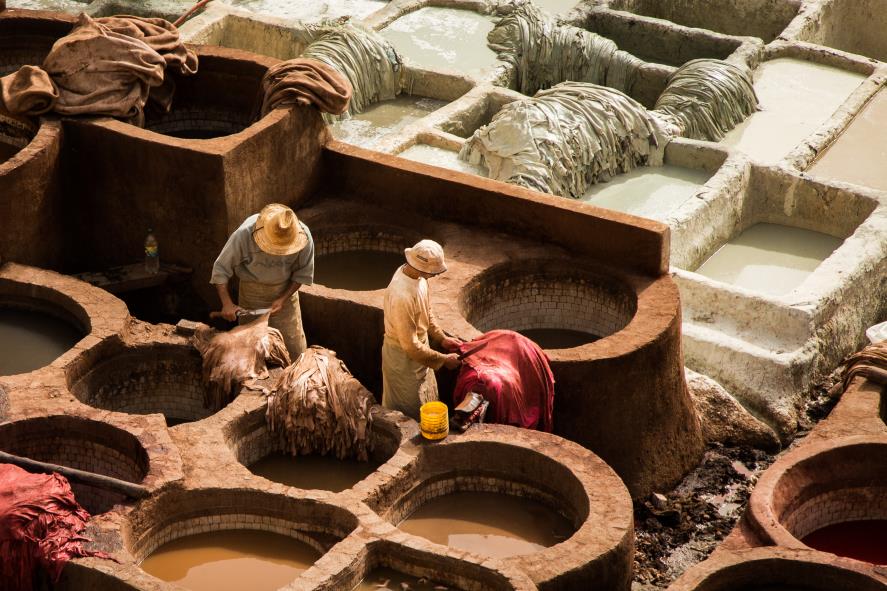
Before leather becomes leather, it undergoes a process called tanning. This process turns the animal hide into leather by altering the skin’s protein structure.
As a result, it prevents bacteria and fungi from breaking down. This prevents decomposition of the hide, maintains its appearance, and makes it enduring. It essentially turns the hide and skin into leather.
There are many tanning methods, but chrome and vegetable tanning are the most popular. Other than these two, there is natural tanning, the use of various chemicals, and tawing.
Chrome tanned leather
The leather made from this process is often considered the best quality. Similar to how chromium makes steel corrosion-resistant, it gives traits likewise to the hide and skin. Chromium prevents decomposition along with acidic salts, most commonly chromium sulfate.
The chrome-tanned leather has a silverish appearance with a uniform texture. It doesn’t develop a patina and maintains the same color throughout its lifespan. Tanners dye and polish the leather in the final process to ensure the colors don’t fade away.
While the colors maintain their looks over time, chrome-tanned leather is more susceptible to cracking. This raises some questions about its durability. They also have an artificial scent that doesn’t feel natural.
The chrome-tanned leather is the most common leather you’ll find in the market. Since this tanning process uses chemicals, it isn’t easy on the environment.
Advantages of chrome-tanned leather
- It’s easy and swift to produce.
- Chrome tanning is the most affordable method to produce leather.
- The leather made following chrome tanning preserves its colors.
Disadvantages of chrome-tanned leather
- It produces chromium particles and harmful wastewater during the process, making it toxic to the environment.
- The leather made following this tanning method can crack pretty quickly.
Vegetable-tanned leather
Vegetable tanning uses the bark and leaves of plants that produce tannins. Many plants have these compounds in sufficient amounts to ensure the hide doesn’t decompose. The tannins tie to the proteins in the skin, making them more resilient against bacteria. It prevents decomposition of the hide, therefore, turning it into leather.
The leather that develops patina is vegetable tanned leather. This tanning method is ideal for a knife sheath material as it’s softer and more flexible than chrome-tanned leather. However, vegetable-tanned leather is initially rigid and needs time to develop a flexible structure.
The vegetable-tanned leather doesn’t dry or crack like the chrome-tanned options. This makes vegetable tanned leather more durable. The leather produced following this tanning process has an earthy smell.
Overall, it makes a durable knife sheath that’s comfortable to wear. The only downside is that vegetable-tanned leather takes up to two months to produce. This ancient tanning method also requires the knowledge of skilled craftspeople. These make it more expensive than chrome-tanned leather.
Advantages of vegetable tanned leather
- It’s eco-friendly and only uses natural materials to produce.
- Vegetable-tanned leather has a pleasant earthy smell.
- It doesn’t crack or dry.
- Vegetable-tanned leather is comfortable to wear.
Disadvantages of vegetable tanned leather
- It doesn’t have lively colors like chrome-tanned leather and may fade away with time.
- The vegetable tanned leather is expensive and takes a long time to produce.
Other options for knife sheath
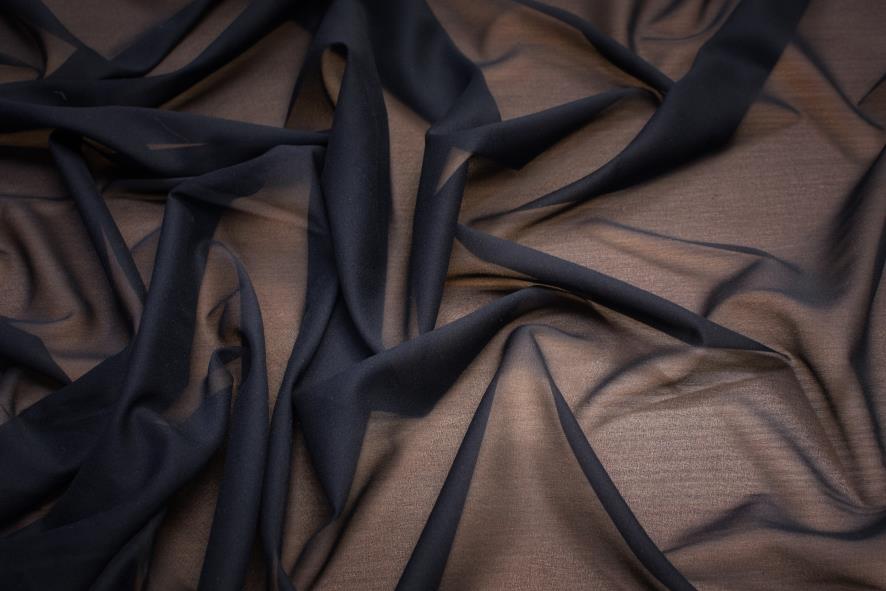
Leather is an amazing choice for knife sheaths. It protects the blade firmly without dulling the edge, is comfortable to wear, and lasts as long as the knife itself with proper care. Still, there are sheaths made from other materials you might be interested in selling in your store.
Here is a quick overview of the other options you have for knife sheaths.
Oxford cloth
While being cloth might make store owners and users doubt its durability, Oxford cloth is a highly durable material. Oxford cloth is thicker in comparison and withstands regular use better.
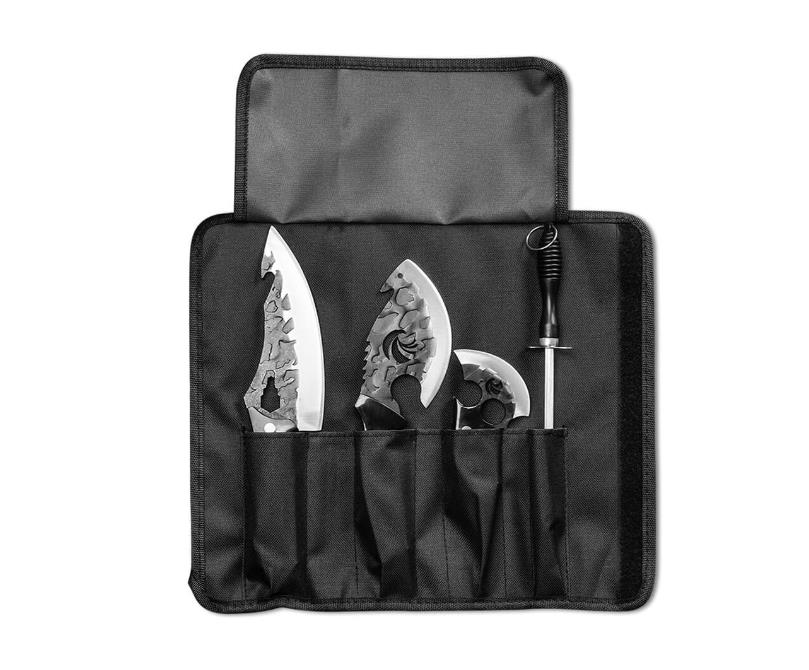
It has a smooth texture with dots, doesn’t get wrinkles, and is suitable for carrying most knives for short periods.
Kydex
Kydex is a thermoplastic widely used in firearms, cars, and kiosks. It’s similar to PVC in many ways with a rigid structure. The sheaths made from Kydex are designed to resist any weather conditions. They don’t require any maintenance from the user and last a long time.
Kydex is like plastic but much more durable and doesn’t get scratched easily. It’s more affordable than leather, waterproof, and comes in various colors.
The downside to them is they hurt the edges of knives faster. It also must fit the blade perfectly. Otherwise, it will wobble around when carrying the knife, risking chips and leading the accidents.
Nylon
Nylon is a common knife sheath material, but not for its practicality. The cost of nylon sheaths is nothing compared to the others in this article. Knife manufacturers hand them out for free as a gift. They aren’t durable, and a sharp blade can slash through them after a few months of use.
Plastic
Plastic knife sheaths are similar to Kydex but less durable. Like the cutting boards made from it, plastic sheaths can get scratched easily. Since it’s a relatively hard material, it can dull the edge fast. Plastic knife sheaths are basically a downgrade from Kydex.
Buy Wholesale Leather Sheath and Start Scaling up with Us Today
Contact us and connect with a sales rep to get a free quote.
Best leather to sell in a knife store
Real leather is the best option for knife sheaths, but the cost of obtaining the material can get expensive. Luckily, there isn’t a single type. You can sell vegetable tanned top grain leather if full grain stretches your customers’ budget.
Even if these seem high, you can choose many knife sheaths built using chrome-tanned leather. You have a broad category of products with leather knife sheaths.
There are also vegan options for leather. PU leather makes an ideal knife sheath for average users. It’s also marketable to professionals and frequent users for their knives that don’t get much use.
As with any other knife material, it’s up to you to decide on finding the best one. Nonetheless, full grain leather is best for large-sized slicing and chef’s knives, top grain leather for every other knife, and split leather for storage.
On our products page for knife sheaths, you can find products made from top grain and full grain leather, PU leather as an artificial alternative, and Oxford cloth.
Want to offer something luxurious and different to your customers? We also have crazy horse leather knife sheaths. Contact us from here to request a quote.
